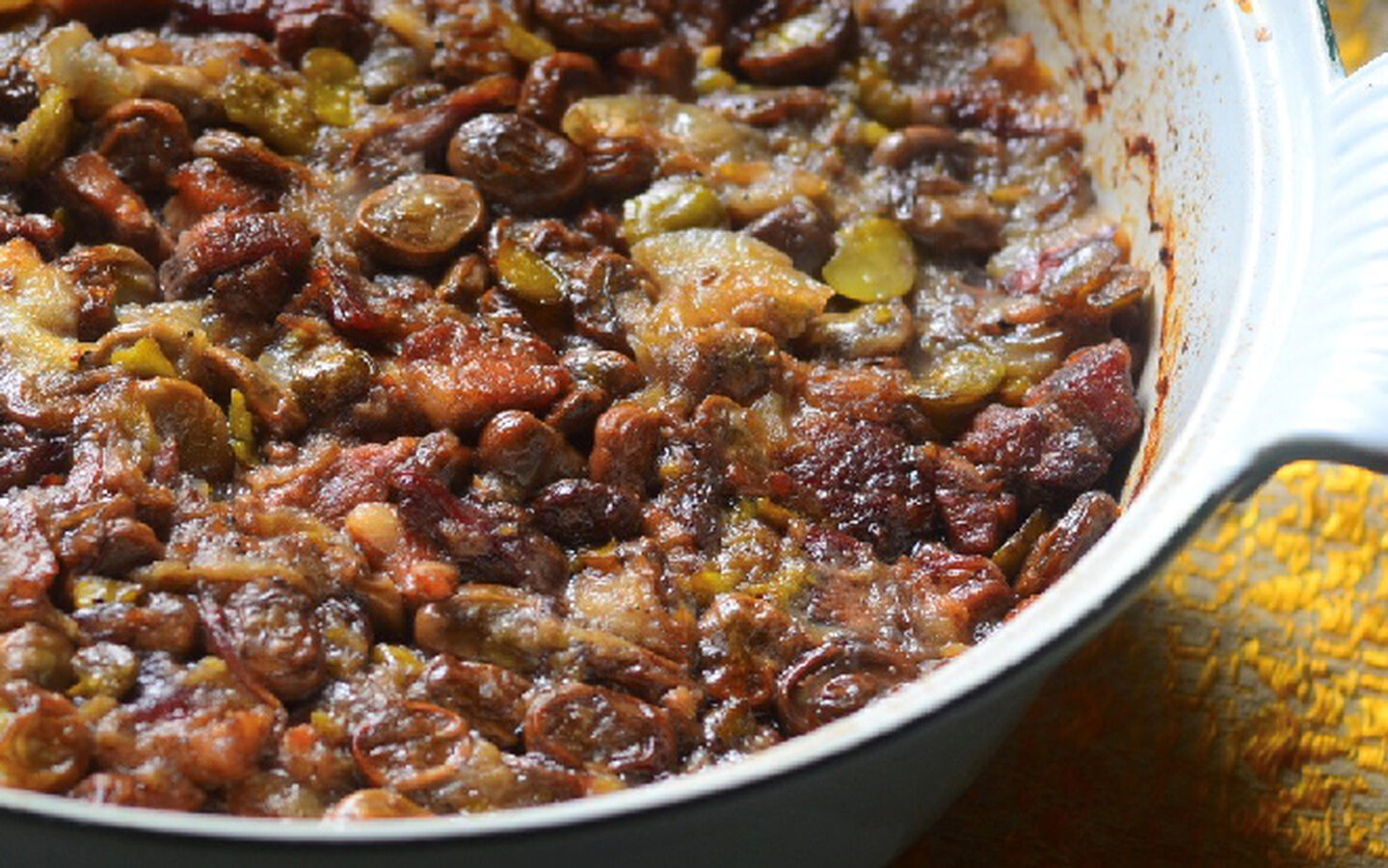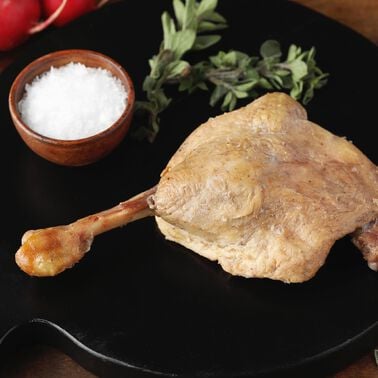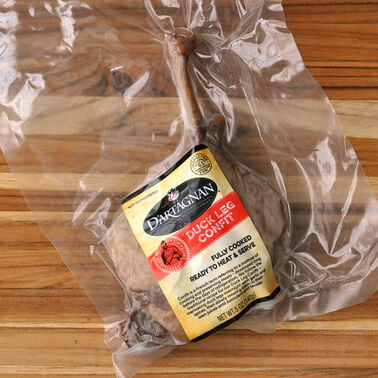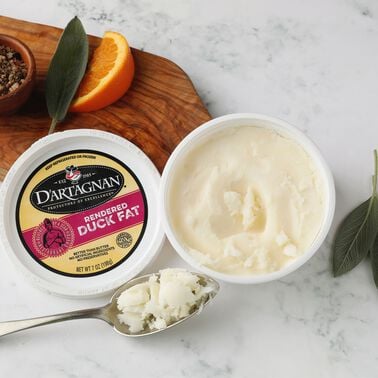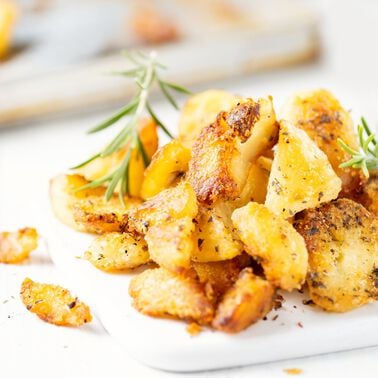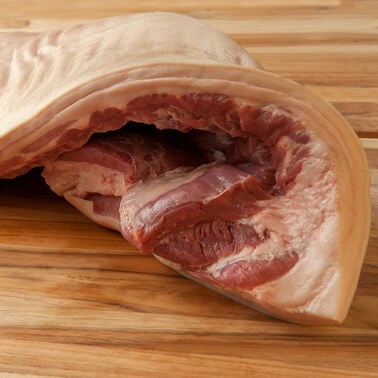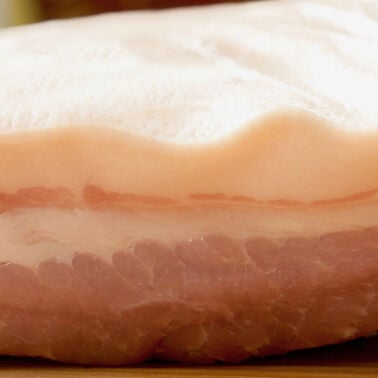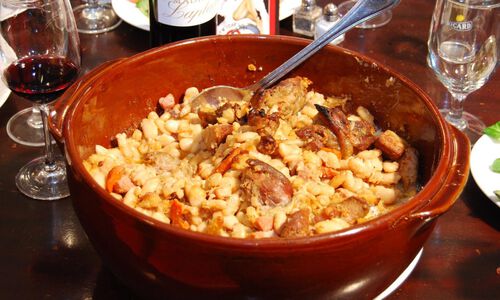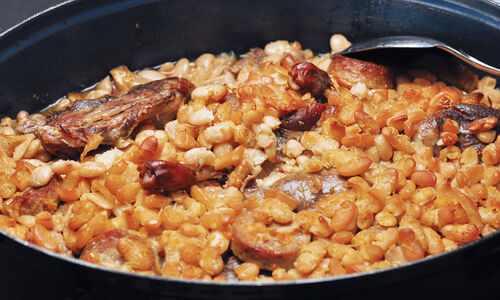Fava Bean Cassoulet (Cassoulet aux Fèves)
- 4 Duck Leg Confit (split at joint)
- 1 cup Duck Fat
- 8-9 pounds of fava beans in their pods
- 1 ¾ -2 pounds small white onions, peeled
- 1 ½ pounds lean fresh Berkshire Pork Belly in 1½” dice blanched, rinsed and dried
- salt
- pepper
- 1 tablespoon sugar
- 6 oz pork skin with ¼ inch layer of fat (cut from the pork belly)
- 1 quart chicken stock
- 1 leek, trimmed, washed and left whole
- 1 large sprig thyme, tied with the leek
- 6 small ribs celery
- 5 firm cloves garlic, peeled
- 1 tablespoon Armagnac (optional)
- Pinches of herbes de Provence, nutmeg, mace and allspice (optional)
- 1 teaspoon fresh marjoram (optional)
- Shuck the beans and discard the pods. You should have 2 quarts of beans. Slip off and discard the skins from 1 cup of the beans, cut the shoots off the rest if you see them, but leave the skins on. The skins will turn dark when you cook them, which is fine.
- Warm the duck leg confit in a pan to melt whatever fat is on them, then remove the duck and save any fat that accumulates – make sure you have 1 cup. Supplement with extra duck fat if necessary.
- Sauté the onions in the reserved duck fat for 4 to 5 minutes in a 6-quart casserole. Add the diced and blanched pork with some pepper and sauté 5 minutes longer, or until it is browned a bit.
- Stir in the peeled favas and sugar. Cover and cook slowly for 10 minutes, mashing the beans a little.
- Simmer pork skin in water till supple, around 15 to 20 minutes. Drain, roll it up and tie it with string.
- Add stock, fava beans, pork skin, leek, celery and garlic. Bring to a boil and skim. Reduce heat, cover with parchment or foil pricked in 2 or 3 places. Simmer for 1½ hours.
- Place duck confit in a colander over steaming water and steam 10 minutes. Remove the duck and cool, then remove the meat from the bones (this is a special trick from Daguin). Remove the duck skin, cut into slices and reserve separately. Cover to keep duck meat moist.
- Preheat oven to 300 degrees.
- Remove the pork skin, unroll, and slice into smaller pieces. Line a 3 – 3 ½ quart casserole with the sliced pork skin, fat side down. (The classic clay cassole is conical, so the wide end at top allows a large surface; use a pot with a wide surface area to create a crust.) Put duck meat on top of that. Remove leek, thyme and celery from the beans and transfer beans to the pot, straining out and saving the liquid/juices.
- Skim the fat from the reserved liquid and add some of the liquid to the pot to just cover the beans, reserving the remaining juices to add as needed. Add the optional herbs and spices. Taste for salt and add more if needed.
- Cover the pot with foil and cook 20 minutes.
- Remove the foil. Spoon off the fat (about a cup). Add only enough juices from the reserved cooking liquid to keep the beans moist. Replace the foil.
- After an hour, remove and discard the foil, then sprinkle the Armagnac over the surface, then push down to blend. Check the beans to see if they need more liquid. Put it back in the oven and allow a crust to form, which takes about 30 minutes.
- Take care not to put in too much of the stock; better to leave a 1 cup or so in reserve and use it if the beans look too dry. You want it to be creamy - not soupy.
- If you have too much liquid, break the crust, push down and add at least another 20 minutes to the cooking time.
- Cook the reserved duck skin in a cast iron pan until crisp. Sprinkle cassoulet with duck skin crisps and serve.
NOTES: André Daguin’s original recipe was published in Paula Wolfert’s very fine book The Cooking of Southwest France, where she describes it as: “crisp on the outside, soft and buttery-tender within. The contrast of flavors and the textures, the beans so full of spring and the Mediterranean, beans that absorbed the taste of the other ingredients and yet, almost paradoxically, maintained a fresh taste of their own –– I could not quite believe what I was eating. It seemed a miracle … Daguin’s cassoulet of fava beans transcended definitions. As far as I was concerned, the cassoulet war was won.”
